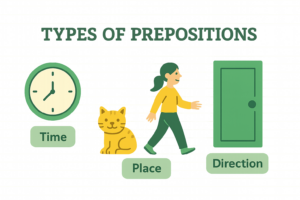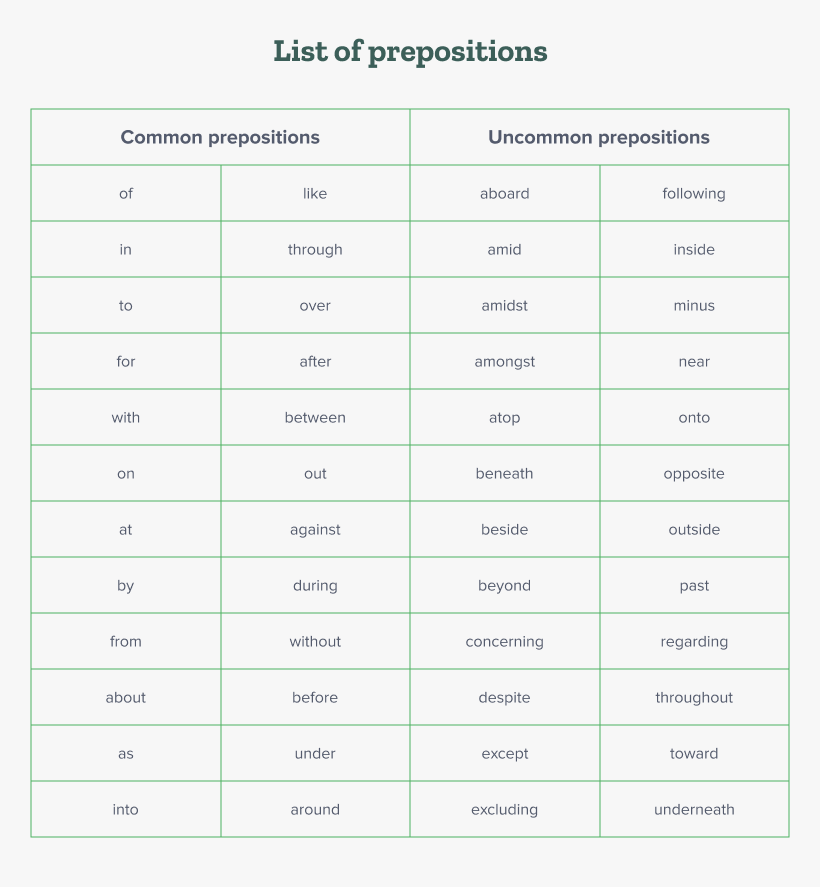Still have questions? Leave a comment

Checklist: Dissertation Proposal
Enter your email id to get the downloadable right in your inbox!

Examples: Edited Papers
Enter your email id to get the downloadable right in your inbox!
Need
Editing and
Proofreading Services?

Preposition: Definition, Meaning, Types, Examples, and List
 Apr 15, 2025
Apr 15, 2025 8
min read
8
min read
Imagine you are looking for something and your friend tells you that it’s “here”.
Here? But where is “here”?
“Right in front of you,” your friend says.
Communication would be so difficult if not for prepositions! In front, behind, against, and many more prepositions are there to help us. This article will decode the meaning of prepositions, their types, and examples. We will also explore common prepositions, their types, and how they are used in sentences.
Plus, there’s also a prepositions list, tips on how to use them, and fun quizzes and exercises to make your understanding of prepositions concrete! So, let’s start by understanding what is a preposition.
Here’s an easy preposition definition to begin with:
What is a preposition?
Prepositions provide context to words, often indicating when, where, or how something happens. They show connections related to time, location, or direction. Prepositions are important because they give essential details that clarify different parts of speech.
It usually comes before a noun (like a person, place, animal, or thing) or a pronoun (like he, she, it), or a noun phrase to show their relationship in terms of time, place, or other details.
For example, in the sentence “The book is on the table,” the word “on” is a preposition that tells us where the book is in relation to the table. Similarly, in “We will meet at 12 PM,” the preposition “at” tells us the time of the meeting.
Without prepositions, sentences would lack clarity and direction, making them vague and confusing. To know in-depth, what a preposition means, take a look at a few preposition examples:
Time: In
Place: Under
Direction: From
What are parts of speech?
Parts of speech are specific roles and functions of a word in the English language. Noun, verb, adjective, adverb, pronoun, preposition, conjunction, and interjection are the eight parts of speech.
You will get a better grasp on things once we look at the different types of prepositions:
Types of prepositions

1. Prepositions of time
Prepositions of time help us specify when something occurs. They indicate when events happen, whether in the past, present, or future. They are crucial for discussing past, present, and future events. To identify prepositions of time in a sentence, look for words that answer the question “When?”.
For instance, we use ‘in’ to refer to centuries, such as ‘in the 21st century’.
Examples of prepositions of time
Here are some time examples to illustrate the usage of prepositions of time:
- “At” is used for precise time.
Meet me at 3 pm.
It rained at 10 o’clock yesterday.
At 6 in the morning, the rally will start.
- “On” is used for days and dates
We will go shopping on Friday.
Their wedding is on 12 March.
On Wednesday, the hotel will be closed.
- “In” is used for months, years, seasons, and parts of the day.
It snows in December.
The trees look red in autumn.
In the afternoon, the classes will begin.
- “Since” is used to indicate the start of a period.
She has been here since morning.
He has not eaten since yesterday.
Since 1999, computers have been used more often.
- “By” is used to indicate deadlines.
Please finish this report by tomorrow.
You have to come home by 10 PM.
By Friday, I’ll complete my project.
2. Prepositions of place
Prepositions of place are used to describe the location or position of nouns. They help us understand the spatial relationship between objects. They help us understand where something is situated. To identify prepositions of place in a sentence, look for words that answer the question “Where?”.
Examples of prepositions of place
Examples of prepositions of place include:
- “At” indicates a specific point or location.
Meet me at the fountain in the park.
She left her keys at the front desk before heading out.
The dog likes to nap at the foot of the bed during the afternoon.
- “In” is used for enclosed spaces, areas, or large geographical locations.
She lives in Germany.
The cat is sleeping in the sunny spot by the window.
He found his favorite book in the top drawer of the desk.
- “On” refers to a surface or a position along a surface.
The pen is on the desk.
The keys are on the kitchen counter next to the coffee machine.
There is a beautiful vase on the shelf above the fireplace.
- “Above” indicates a higher position relative to a point of reference, without physical contact.
Hang the picture above the sofa.
The clock hanging above the mantelpiece is almost a century old.
A flock of birds soared above the lake.
- “Below” indicates a lower position relative to a point of reference.
The fish swim below the surface of the water.
The storage room is located below the main floor of the house.
They noticed a bright coral reef just below the surface of the water.
- “Under” is similar to below but often implies that something is directly beneath another thing, possibly covered by it.
The boy hid under the bed during the thunderstorm.
She keeps all her board games stored under the staircase.
The picnic area is located under the large oak tree at the park.
- “Over” indicates that something is positioned directly above something else, and can also imply covering or moving across.
There is a bridge over the river.
A colorful banner stretched over the entrance.
She threw her clothes all over the bed.
- “Beside” indicates next to or at the side of something.
Park your bike beside mine.
She sat beside her friend at the café.
The lamp is placed beside the sofa in the living room.
- “Between” indicates in the middle of two or more points.
The coffee shop is situated between the bookstore and the bakery.
The small cottage is nestled between two towering mountains.
She found her lost earring between the couch cushions.
- “Among” indicates surrounded by; in the middle of a group or collection.
She was sitting among a group of students.
The ancient ruins were hidden among dense forests.
She distributed the snacks among the children at the party.
- “Across” indicates from one side to the other, implying a crossing over.
The zebra crossing goes across the busy street.
She lives just across the street from the library.
The bridge stretches across the river connecting the two towns.
- “Around” indicates in a circular direction or position; surrounding something.
We gathered around the fire to keep warm.
The path winds around the lake leading to the hilltop.
He looked around the room, searching for his bag.
- “Near” indicates close to; not far away in distance.
There is a nice park near my house.
The parking lot is near the entrance of the museum.
There is a bakery near the corner of the street.
- “Against” shows in contact with something, typically in a way that provides support or resistance.
He leaned against the wall.
The waves crashed against the rocky shore.
She rested the painting against the back of the chair.
- “Within” indicates inside or not further than an area or period of time.
You should receive a reply within 24 hours.
The café is within walking distance of her office.
He found the solution within the first chapter of the book.
However, is “in” a preposition of time or place? Similarly, is “on” a preposition of time or place? The answer is that “in” and “on” can be used as both, prepositions of time and prepositions of place. What makes them different is the context they are being used in.
3. Prepositions of direction
These prepositions tell us about the direction in which something or someone moves. They are essential for describing movement and location in sentences. They are dynamic, indicating movement. To identify prepositions of place in a sentence, look for words that answer the question “From Where” or “To Where”.
Examples of prepositions of direction
In the following sentences, we will see examples of prepositions of direction:
- “To” indicates movement towards a specific destination.
She is going to the office.
He sent a letter to his friend in Canada.
The children ran to the playground.
- “From” indicates the starting point of a movement.
He travels from Chicago to New York often.
This gift is from all of us at the office.
She learned the recipe from her grandmother.
- “Into” indicates movement towards the inside of a place.
She walked into the room.
The cat jumped into the empty box on the floor.
Pour the water into the glass slowly.
- “Out of” indicates movement from inside to outside.
He ran out of the house.
She took the book out of the bag
The magician pulled a rabbit out of his hat.
- “Through” indicates moving from one side to the other within something.
They drove through the tunnel.
The tour group walked through the ancient ruins.
She read through the document before signing it.
- “Across” indicates movement from one side to the other over a surface.
She swam across the lake.
The chicken ran across the road.
She glanced across the room.
Preposition examples
To understand different prepositions better, let’s look at some more preposition examples and how they are used in a sentence. These examples will show how prepositions indicate when and where events happened!
It rains a lot in April. (In indicates a specific time.)
The cat is sleeping under the bed. (Under indicates a specific space.)
I will meet you at the entrance. (At indicates a specific location.)
She travels from New York to London often. (From indicates a specific direction.)
But, there’s a trap here! In the phrase “from New York to London”, if “from” tells you the direction then so does “to” right? So, is “to” a preposition?
Yes. “To” is also a preposition that indicates a direction.
Some prepositions can create confusion, especially for second language learners, due to their multiple meanings.
Now that we’ve seen so many preposition examples, let’s have a small fun quiz to test your learning:
- Is “with” a preposition?
Ans: Yes
- Is “of” a preposition?
Ans: Yes
- Is “for” a preposition?
Ans: Yes
Don’t worry if you got some answers wrong. Here’s the most commonly used prepositions list for you. As a bonus, we’ve also got an uncommon prepositions list:

Verbs followed by prepositions
In English, many verbs are commonly followed by specific prepositions. These pairings are crucial because the prepositions can alter the meaning of the verb or make it whole.
Some common examples are:
- She agrees with you on that. (The verb “agrees” is followed by the preposition “with”)
- She asked for a glass of water. (The verb “asked” is followed by the preposition “for”)
- The test consists of two parts. (The verb “consists” is followed by the preposition “of”)
- The team focused on winning. (The verb “focused” is followed by the preposition “on”)
- You can rely on me to help you. (The verb “rely” is followed by the preposition “on”)
It is important to note that different verbs can share the same preposition, which is crucial for effective usage.
Adjectives followed by prepositions
Just like verbs, many adjectives in English are commonly paired with specific prepositions. These combinations are key for pinpointing relationships and can shift the meaning or context of your description.
Some common examples are:
- She is afraid of spiders. (The adjective “afraid” is followed by the preposition “of”)
- He was angry at the news. (The adjective “angry” is followed by the preposition “at”)
- He is very fond of his parents. (The adjective “fond” is followed by the preposition “of”)
- I’m tired of all the noise. (The adjective “tired” is followed by the preposition “of”)
- He’s keen on playing chess. (The adjective “keen” is followed by the preposition “on”)
These combinations of adjectives and prepositions form phrases that are essential for clear communication.
Ending a sentence with a preposition
Ending a sentence with a preposition is something that often happens in spoken and written English, even though traditional grammar rules used to frown upon it. When we speak casually, it’s common and perfectly natural to end sentences with prepositions.
For example:
What are you thinking about? (the preposition “about” ends the sentence.)
This is more conversational and easier to use than the more formally correct “About what are you thinking?”
Who did you go with? (the preposition “with” ends the sentence.)
The idea that ending sentences with prepositions is incorrect is actually a myth.
Ending sentences with prepositions can make speech sound more natural and less forced, which is why it’s commonly accepted in everyday English. Here are more examples where sentences naturally end with prepositions:
- Where did you come from?
- What are you looking for?
- That’s the company I work for.
- Which university did she graduate from?
- What movie are you interested in?
- Who were you talking to?
- What chair should I sit on?
- That’s something I haven’t thought about.
- Which team are you rooting for?
- What is the remote control for?
Rules for using prepositions
- Ensure that the preposition essential for meaning is not dropped.
She is married to him (not just “She is married him”).
- Avoid inserting prepositions where they are not needed.
Let’s meet next Monday (not “Let’s meet on next Monday”).
- Phrasal verbs often pair verbs with specific prepositions or adverbs, creating meanings that are not predictable from the individual elements.
Look up the information (not “look at” the information).
- Some expressions use prepositions in ways that are fixed and might not follow normal rules. These should be learned as complete phrases.
At odds with, in favor of, on behalf of.
- Keep them close to what they modify: To avoid confusion, place prepositional phrases close to the nouns or verbs they modify.
The cake with whipped cream was delicious (not “The cake was delicious with whipped cream”).
To solidify your knowledge of prepositions, the last thing you can do is solve this prepositions exercise.
We’ve specially crafted this exercise for you, which you can solve with the help of extensive preposition examples, a list of prepositions, and the meaning of prepositions that we’ve learned before!
Exercise Instructions
Read the sentences below and fill in the blanks with the correct prepositions.
- She has been studying hard ___ the library since morning.
- We will meet ___ the coffee shop ___ 3 PM.
- The cat is hiding ___ the sofa.
- They traveled ___ car ___ the two cities.
- The meeting continued ___ lunch.
Mastering the use of prepositions can enhance your language skills. Whether you’re writing a business proposal, crafting a professional email, or preparing an academic paper, understanding these combinations is crucial. It is important to proofread your documents and make sure they do not have any grammar mistakes.
If you’re looking to perfect your writing even further, consider PaperTrue’s expert editing and proofreading services. Our team of professionals can help refine your document, ensuring every preposition is perfectly placed for maximum clarity and impact!
Here are some more grammar articles for you:
Frequently Asked Questions






